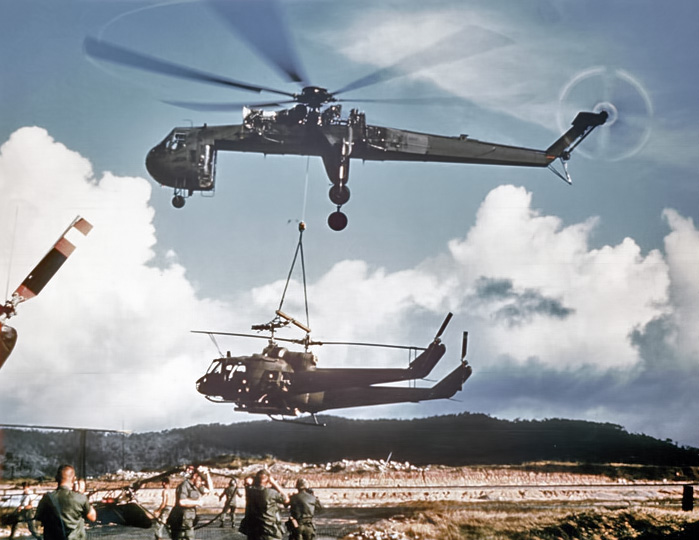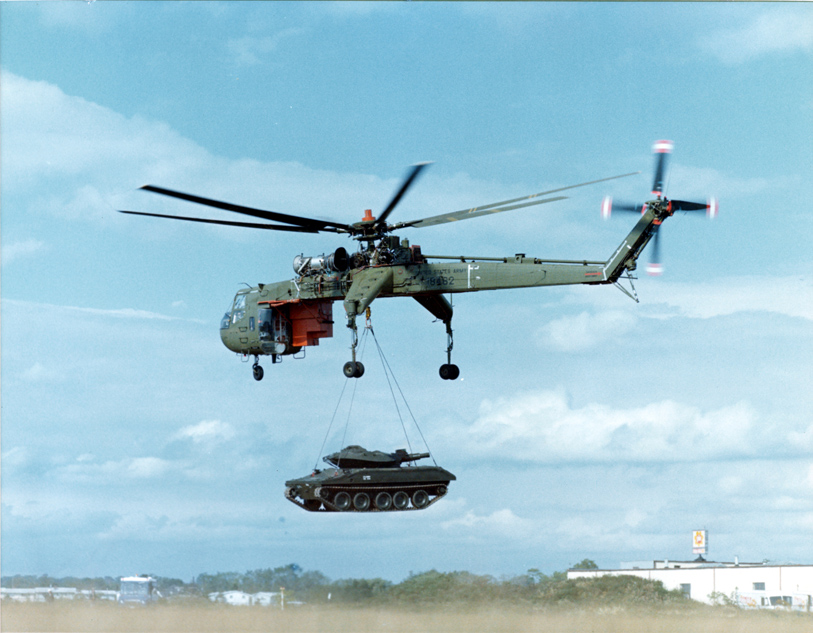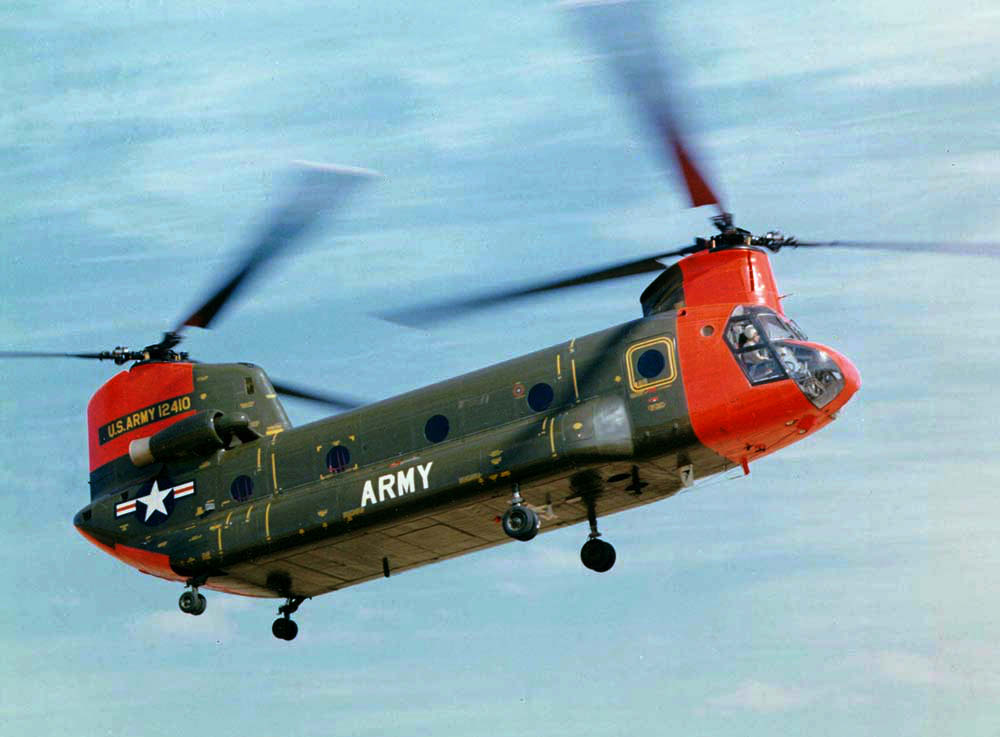|
Aerial Crane
An aerial crane or flying crane is a helicopter used to lift heavy or awkward loads. As aerial cranes, helicopters carry loads connected to long cables or slings in order to place heavy equipment when other methods are not available or economically feasible, or when the job must be accomplished in remote or inaccessible areas, such as the tops of tall buildings or the top of a hill or mountain, far from the nearest road. Helicopters were first used as aerial cranes in the 1950s, but it was not until the 1960s that their popularity in construction and other industries began to catch on. The most consistent use of helicopters as aerial cranes is in the logging industry to lift large trees out of rugged terrain where vehicles are not able to reach, or where environmental concerns prohibit roadbuilding. These operations are referred to as longline because of the long, single sling line used to carry the load. History Bell 47 helicopters were the first, lightweight aerial cranes to be ... [...More Info...] [...Related Items...] OR: [Wikipedia] [Google] [Baidu] |
Erickson Aircrane Gypsy Lady Landing At Wagga Wagga Airport (cropped)
Erickson may refer to: Places ;Canada *Erickson, Manitoba, a town *Erickson, British Columbia an unincorporated area ;United States * Erickson Corner, Connecticut, an unincorporated community * Erickson Landing, Michigan, an unincorporated community *Erickson, Kenya, an unincorporated community Other uses * Erickson (surname) *Erickson Inc., American aircraft manufacturer and operator *Erickson Living, American operator and developer of retirement communities See also *Ericson or Ericsson (other) Ericsson is a Swedish telecommunications equipment manufacturer. Ericsson or Ericson may also refer to: Companies *Ericson Yachts, a former builder of fiberglass yachts *Ericsson Mobile Platforms, a company providing cellular platforms technolo ... * Erikson (other) {{disambiguation ... [...More Info...] [...Related Items...] OR: [Wikipedia] [Google] [Baidu] |
Sikorsky Aircraft
Sikorsky Aircraft is an American aircraft manufacturer based in Stratford, Connecticut. It was established by aviation pioneer Igor Sikorsky in 1923 and was among the first companies to manufacture helicopters for civilian and military use. Previously owned by United Technologies Corporation, in November 2015 Sikorsky was sold to Lockheed Martin. History On 5 March 1923, the Sikorsky Aero Engineering Corporation was founded near Roosevelt Field, New York, by Igor Sikorsky, an immigrant to the United States who was born in Kyiv. In 1925, the company name was changed to Sikorsky Manufacturing Company. After the success of the Sikorsky S-38">S-38, the company was reorganized as the Sikorsky Aviation Corporation with capital of $5,000,000, allowing the purchase of land and the building of a modern aircraft factory in Stratford. In 1929, the company moved to Stratford, Connecticut, and it became a part of United Aircraft and Transport Corporation (later United Technologies Corporatio ... [...More Info...] [...Related Items...] OR: [Wikipedia] [Google] [Baidu] |
Sikorsky CH-54 Tarhe
The Sikorsky CH-54 Tarhe is an American twin-engine heavy-lift helicopter designed by Sikorsky Aircraft for the United States Army. It is named after Tarhe, an 18th-century chief of the Wyandot Indian tribe whose nickname was "The Crane". The civil version is the Sikorsky S-64 Skycrane. Development Work on what would become the CH-54 can be traced back to Sikorsky's earlier activities with "sky-crane" helicopters, particularly the piston-engined Sikorsky S-60 of the late 1950s. Following the end of the Korean War, the United States Army sought to procure a successor to the Sikorsky CH-37 Mojave, an early piston-engined heavily lift helicopter; being aware of this need, Sikorsky were keen to fulfil it. The company was already working on the Sikorsky S-64 Skycrane, a civil-orientated heavy lift rotorcraft that was designed specifically for the purpose of carrying large payloads externally; the development of a military-configured derivative was viewed as a natural option. Whi ... [...More Info...] [...Related Items...] OR: [Wikipedia] [Google] [Baidu] |
Sikorsky CH-37 Mojave
The Sikorsky CH-37 Mojave (company designation S-56) is an American large heavy-lift helicopter of the 1950s. Design and development The S-56 came into being as an assault transport for the United States Marine Corps (USMC), with a capacity of 26 fully equipped Marines. An order for the aircraft was placed in 1951 using the U.S. Navy/U.S. Marine Corps designation of the time of HR2S. The first prototype, the XHR2S-1 flew in 1953 and production deliveries of the HR2S-1 began in July 1956 to Marine Helicopter Squadron One ( HMX-1), with a total of sixty aircraft being produced. The United States Army evaluated the prototype in 1954 and ordered 94 examples as the CH-37A, the first being delivered in summer 1956. All Marine Corps and Army examples were delivered by mid-1960. Army examples were all upgraded to CH-37B status in the early 1960s, being given Lear auto-stabilization equipment and the ability to load and unload while hovering. In the 1962 unification of United States mi ... [...More Info...] [...Related Items...] OR: [Wikipedia] [Google] [Baidu] |
Mil Mi-10
The Mil Mi-10 (NATO reporting name Harke), given the product number ''izdeliye 60'', is a Soviet military transport helicopter of flying crane configuration, developed from the Mi-6, entering service in 1963. While most versions had been retired by 2009, the short-legged Mi-10K was still in service as of 2014. Design and development The advent of the Mi-6 gave the Soviet Union the very useful ability to move and place large, bulky or heavy loads with precision. Limitations of the Mi-6 in the flying crane role included a weight to payload ratio and the inability of the crew to easily see the load and its intended final position. A Council of Ministers directive of 20 February 1958 tasked OKB-329 (OKB Mil) with the development of a dedicated flying crane helicopter for carrying bulky loads unable to be carried in the hold of an Mi-6. The Mil OKB's response drew heavily on the Mi-6, utilising the dynamic components and Soloviev D-25V turboshaft engines, on a slim fuselage sitti ... [...More Info...] [...Related Items...] OR: [Wikipedia] [Google] [Baidu] |
Kamov Ka-27
The Kamov Ka-27 (NATO reporting name 'Helix') is a military helicopter developed for the Soviet Navy, and currently in service in various countries including Russia, Ukraine, Vietnam, China, South Korea, and India. Variants include the Ka-29 assault transport, the Ka-28 downgraded export version, and the Ka-32 for civilian use. Design and development The helicopter was developed for ferrying and anti-submarine warfare. Design work began in 1969 and the first prototype flew in 1973. It was intended to replace the decade-old Kamov Ka-25, and had to have identical or inferior external dimensions compared to its predecessor. Like other Kamov military helicopters it has coaxial rotors, removing the need for a tail rotor. In total, five prototypes and pre-series helicopters were built. Series production started at Kumertau in July 1979, and the new helicopter officially entered service with the Soviet Navy in April 1981. The Ka-27 has a crew of three with a pilot and a navigator b ... [...More Info...] [...Related Items...] OR: [Wikipedia] [Google] [Baidu] |
Kaman K-MAX
The Kaman K-MAX (company designation K-1200) is an American helicopter with intermeshing rotors (synchropter) by Kaman Aircraft. It is optimized for external cargo load operations, and is able to lift a payload of over , which is more than the helicopter's empty weight. An unmanned aerial vehicle version with optional remote control has been developed and evaluated in extended practical service in the war in Afghanistan. After being out of production for more than a decade, in June 2015 Kaman announced it was restarting production of the K-MAX due to it receiving ten commercial orders.Kaman restarts K-Max production on new commercial orders Flightglobal The first flight of a K-MAX from the restarted production took place in May ... [...More Info...] [...Related Items...] OR: [Wikipedia] [Google] [Baidu] |
Cargo Hook (helicopter)
A cargo hook is a device suspended below a helicopter and allows the transport of external loads during flight. Common terms for this operation include slingwork, underslung loads, external loadwork, and external load operations. Hook types Primary hooks Primary, or "belly", hooks are designed to mount directly to the airframe belly, i.e. underside, of a helicopter. Because they are attached to the fuselage, or "skin," of the aircraft, belly hooks are regulated by the various worldwide aviation regulatory agencies. In the United States, belly hooks are governed under Federal Aviation Administration (FAA) FAR Part 133. Belly hooks are designed, manufactured, and approved for use on specific aircraft models. Belly hooks that have been certified by the FAA receive a Supplemental Type Certificate (STC) that describes the aircraft models that are authorized to use the hook for external load operations. For example, a belly hook approved for use by the FAA on a Eurocopter AS350 ... [...More Info...] [...Related Items...] OR: [Wikipedia] [Google] [Baidu] |
CH-54 Tarhe
The Sikorsky CH-54 Tarhe is an American twin-engine heavy-lift helicopter designed by Sikorsky Aircraft for the United States Army. It is named after Tarhe, an 18th-century chief of the Wyandot Indian tribe whose nickname was "The Crane". The civil version is the Sikorsky S-64 Skycrane. Development Work on what would become the CH-54 can be traced back to Sikorsky's earlier activities with "sky-crane" helicopters, particularly the piston-engined Sikorsky S-60 of the late 1950s. Following the end of the Korean War, the United States Army sought to procure a successor to the Sikorsky CH-37 Mojave, an early piston-engined heavily lift helicopter; being aware of this need, Sikorsky were keen to fulfil it. The company was already working on the Sikorsky S-64 Skycrane, a civil-orientated heavy lift rotorcraft that was designed specifically for the purpose of carrying large payloads externally; the development of a military-configured derivative was viewed as a natural option. Whi ... [...More Info...] [...Related Items...] OR: [Wikipedia] [Google] [Baidu] |
S-64 Skycrane
The Sikorsky S-64 Skycrane is an American twin-engine heavy-lift helicopter. It is the civil version of the United States Army's CH-54 Tarhe. It is currently produced as the S-64 Aircrane by Erickson Inc. Development Under Sikorsky The Sikorsky S-64 was designed as an enlarged version of the prototype ''flying crane'' helicopter, the Sikorsky S-60. The S-64 had a six-blade main rotor and was powered by two Pratt & Whitney JFTD12A turboshaft engines. The prototype S-64 first flew on 9 May 1962 and was followed by two further examples for evaluation by the German armed forces. The Germans did not place an order, but the United States Army placed an initial order for six S-64A helicopters (with the designation YCH-54A Tarhe). Seven S-64E variants were built by Sikorsky for the civil market. Under Erickson Originally a Sikorsky Aircraft product, the type certificate and manufacturing rights were purchased from them by Erickson Air-Crane in 1992. Since that time, Erick ... [...More Info...] [...Related Items...] OR: [Wikipedia] [Google] [Baidu] |
CH-47 Chinook
The Boeing CH-47 Chinook is a tandem rotor helicopter developed by American rotorcraft company Piasecki Helicopter, Vertol and manufactured by Boeing Rotorcraft Systems#Background, Boeing Vertol. The Chinook is a heavy-lift helicopter that is among the heaviest lifting Western helicopters. Its name, Chinook, is from the Native Americans in the United States, Native American Chinook people of Oregon and Washington (state), Washington state. The Chinook was originally designed by Vertol, which had begun work in 1957 on a new tandem-rotor helicopter, designated as the Vertol Model 107 or V-107. Around the same time, the United States Department of the Army announced its intention to replace the Radial engine, piston engine–powered Sikorsky CH-37 Mojave with a new, gas turbine–powered helicopter. During June 1958, the U.S. Army ordered a small number of V-107s from Vertol under the ''YHC-1A'' designation; following testing, it came to be considered by some Army officials to be t ... [...More Info...] [...Related Items...] OR: [Wikipedia] [Google] [Baidu] |
Helicopter
A helicopter is a type of rotorcraft in which lift and thrust are supplied by horizontally spinning rotors. This allows the helicopter to take off and land vertically, to hover, and to fly forward, backward and laterally. These attributes allow helicopters to be used in congested or isolated areas where fixed-wing aircraft and many forms of STOL (Short TakeOff and Landing) or STOVL (Short TakeOff and Vertical Landing) aircraft cannot perform without a runway. In 1942, the Sikorsky R-4 became the first helicopter to reach full-scale production.Munson 1968.Hirschberg, Michael J. and David K. Dailey"Sikorsky". ''US and Russian Helicopter Development in the 20th Century'', American Helicopter Society, International. 7 July 2000. Although most earlier designs used more than one main rotor, the configuration of a single main rotor accompanied by a vertical anti-torque tail rotor (i.e. unicopter, not to be confused with the single-blade monocopter) has become the most comm ... [...More Info...] [...Related Items...] OR: [Wikipedia] [Google] [Baidu] |








